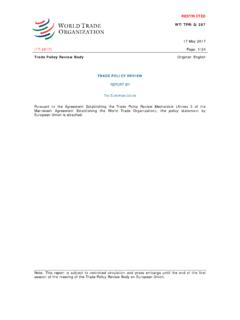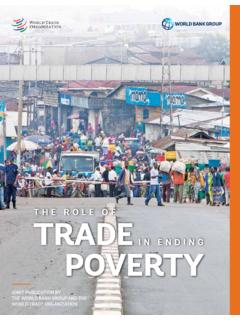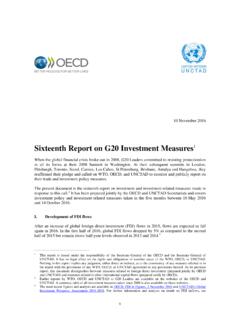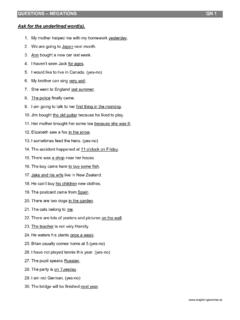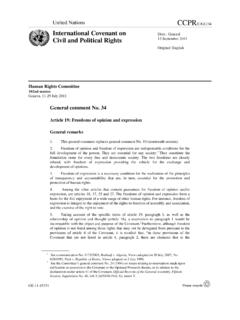Transcription of THE ECONOMIC IMPACT OF COVID-19 ON WOMEN IN …
1 3 August 2020 Page: 1/9 Original: english THE ECONOMIC IMPACT OF COVID-19 ON WOMEN IN vulnerable SECTORS AND economies INFORMATION NOTE1 KEY POINTS: WOMEN are at risk of suffering more than men from the trade disruption generated by the COVID-19 pandemic. One of the reasons for this is that a larger share of WOMEN works in sectors and types of firms that have been particularly hard-hit by the pandemic. WOMEN make up a larger share of the workforce in the manufacturing sectors, such as textiles, apparel, footwear and telecommunication products, that experienced some of the largest falls in export growth during the first months of the pandemic. For example, female employees represent 80 per cent of the workforce in ready-made garment production in Bangladesh, in which industry orders declined by per cent over the first quarter of 2020, and by 81 per cent in April alone.
2 A larger share of WOMEN than men works in services, such as tourism and business travel services, that have been directly affected by regional and international travel restrictions. A large share of firms owned or managed by WOMEN are micro, small and medium-sized enterprises (MSMEs), and lower levels of financial resources and limited access to public funds are placing the survival of such businesses at greater risk. The ECONOMIC IMPACT of the pandemic is expected to be particularly significant for WOMEN in least-developed and developing economies because fewer WOMEN than men are employed in these economies in occupations which can be undertaken remotely, and a larger share of WOMEN is employed in sectors highly exposed to international travel restrictions.
3 The effects of the pandemic are aggravating existing vulnerabilities. Many channels through which COVID-19 is having a greater IMPACT on WOMEN are those at the heart of gender inequalities, such as lower wages for WOMEN , fewer educational opportunities, limited access to finance, greater reliance on informal employment and social constraints. Limited access to digital technologies and lower rates of information technology (IT) skills further reduce WOMEN 's opportunities for teleworking and e-commerce, and thus for adapting to the current crisis. Many governments have adopted a broad range of support measures to help individuals and businesses. Some of these measures, mainly social protection initiatives adopted by some central or local governments, are specifically targeted at WOMEN .
4 Maintaining open trade during the ECONOMIC recovery period is key to building faster and more inclusive growth. The joint World Bank and World Trade Organization report on trade and gender, " WOMEN and Trade: the role of trade in promoting gender equality", published in July 2020, highlights ways in which trade can continue to benefit WOMEN in the post- COVID-19 recovery period. 1 This document has been prepared under the WTO Secretariat's own responsibility and is without prejudice to the positions of WTO members or to their rights and obligations under the WTO. 2 1. INTRODUCTION Although the ECONOMIC IMPACT of COVID-19 pandemic is still emerging, early evidence suggests that the pandemic is likely to hit WOMEN disproportionately hard.
5 The IMPACT on WOMEN is likely to exceed that of past crises because of COVID-19 safety measures, and to affect many sectors with a larger share of female employees, and the crisis is likely to have a particularly negative IMPACT on WOMEN in low-income countries. This information note explores why the ECONOMIC IMPACT is likely to affect WOMEN disproportionately. Travel restrictions and border closures have severely affected trade in services, especially in sectors dependent on people travelling abroad, such as In manufacturing, the disruption of business travel and the lockdown have had a particularly large IMPACT on sectors dependent on global value chains, as well as on season-sensitive sectors in which many WOMEN work, such as textiles and clothing.
6 Keeping international markets open during the COVID-19 pandemic has been crucial in providing affordable access to essential food and medical products. The pandemic has also highlighted how the temporary movement of healthcare workers, of whom many are WOMEN , has particularly helped the most affected countries to deal with the crisis. Maintaining open markets during the recovery period is key to building faster, more inclusive growth. As economies emerge from the pandemic crisis, governments may find ECONOMIC recovery strengthened if they specifically address the constraints faced by WOMEN . For example, in some sectors, teleworking has proved to be a tool to mitigate the IMPACT of the crisis, but access to digital connections and IT skills rates are much lower for WOMEN in certain economies .
7 In addition, lower financial resources and inequality of access to public funds put the survival of WOMEN 's businesses at greater risk. 2. THE ECONOMIC IMPACT OF COVID-19 HIGHLIGHTS THE PRECARITY OF WOMEN 'S EMPLOYMENT Preliminary evidence for the United States suggests that WOMEN are being hit harder than men by the COVID-19 crisis. According to official statistics, in April 2020, US monthly unemployment rates rose sharply from to per cent for adult men, and from to per cent for adult WOMEN (Figure 1).3 A similar pattern has been observed in Canada, where WOMEN face a higher rate of unemployment than Many of the different channels through which COVID-19 is having a greater IMPACT on WOMEN are those at the heart of gender inequalities.
8 Wage and educational gaps, as well as limited access to finance, a greater proportion of WOMEN in informal employment and social constraints all tend to make WOMEN more vulnerable to ECONOMIC recessions. 2 WTO (2020), Trade in services in the context of COVID-19 . 3 Recent estimations report higher figures for unemployment rates in the United States, including for WOMEN ( ). In addition, monthly unemployment rates for April 2020 reported by the OECD for other countries, such as Israel, Japan and the Republic of Korea, do not appear to show any IMPACT of the crisis yet (see ). 4 Kelsey Johnson, (2020), "Canadian youth, WOMEN hit hard by massive coronavirus-related job losses".
9 3 Figure 1: US unemployment rate for WOMEN and men Source: US Bureau of Labor Statistics. However, this crisis is having a different IMPACT from previous global crises. Past recessions have typically had a greater negative IMPACT on men's employment because more men work in sectors most exposed to business cycles, such as construction and manufacturing, while WOMEN s employment is concentrated in relatively less cyclical sectors, such as education and healthcare. The COVID-19 recession is likely to have a harsher IMPACT on female workers and entrepreneurs because the sectors in which they are economically active are among those most affected by lockdown and distancing Many WOMEN are employed in jobs which have been critical to the COVID-19 response, such as health and social care, and in essential sectors, such as sales of food and other necessary This has meant continued employment but also greater exposure to the virus.
10 At the same time, WOMEN are disproportionately represented in a large number of activities requiring face-to-face interactions, such as retail, which prevents them from telecommuting (Figure 2).7 Figure 2: Occupations undertaken by telecommuting and by face-to-face interactions Source: Authors own estimations based on telecommuting data based in Alon et al. (2020) and face-to-face data in Avdiu and Nayyar (2020). 5 See Alon, T., Doepke, M., Olmstead-Rumsey, J. and Tertilt, M. (2020), "The IMPACT of COVID-19 on Gender Equality", CRC TR 224 Discussion Paper Series crctr224_2020_163, University of Bonn and University of Mannheim, Germany and Adams-Prassl, A., Boneva, T., Golin, M.
